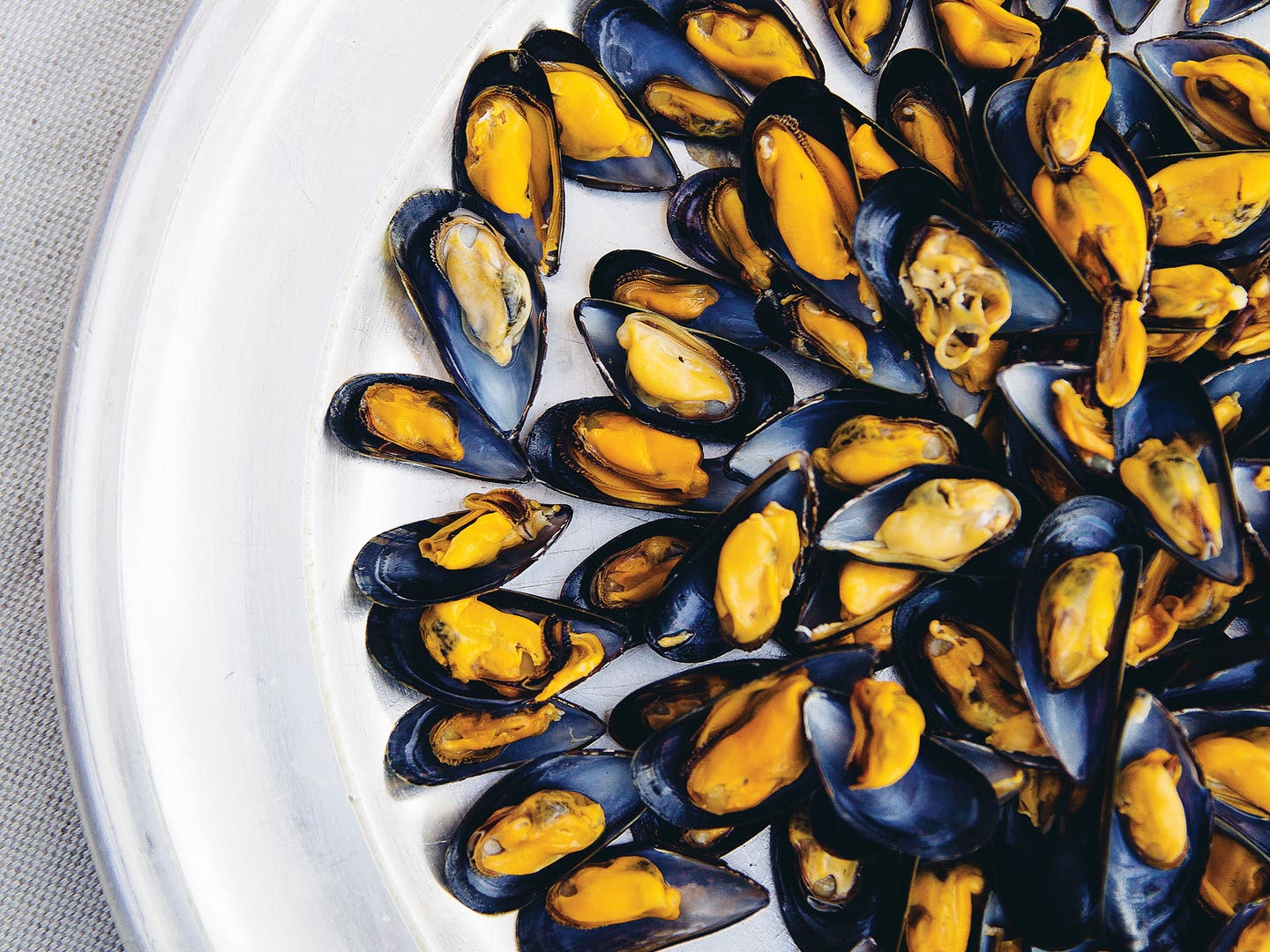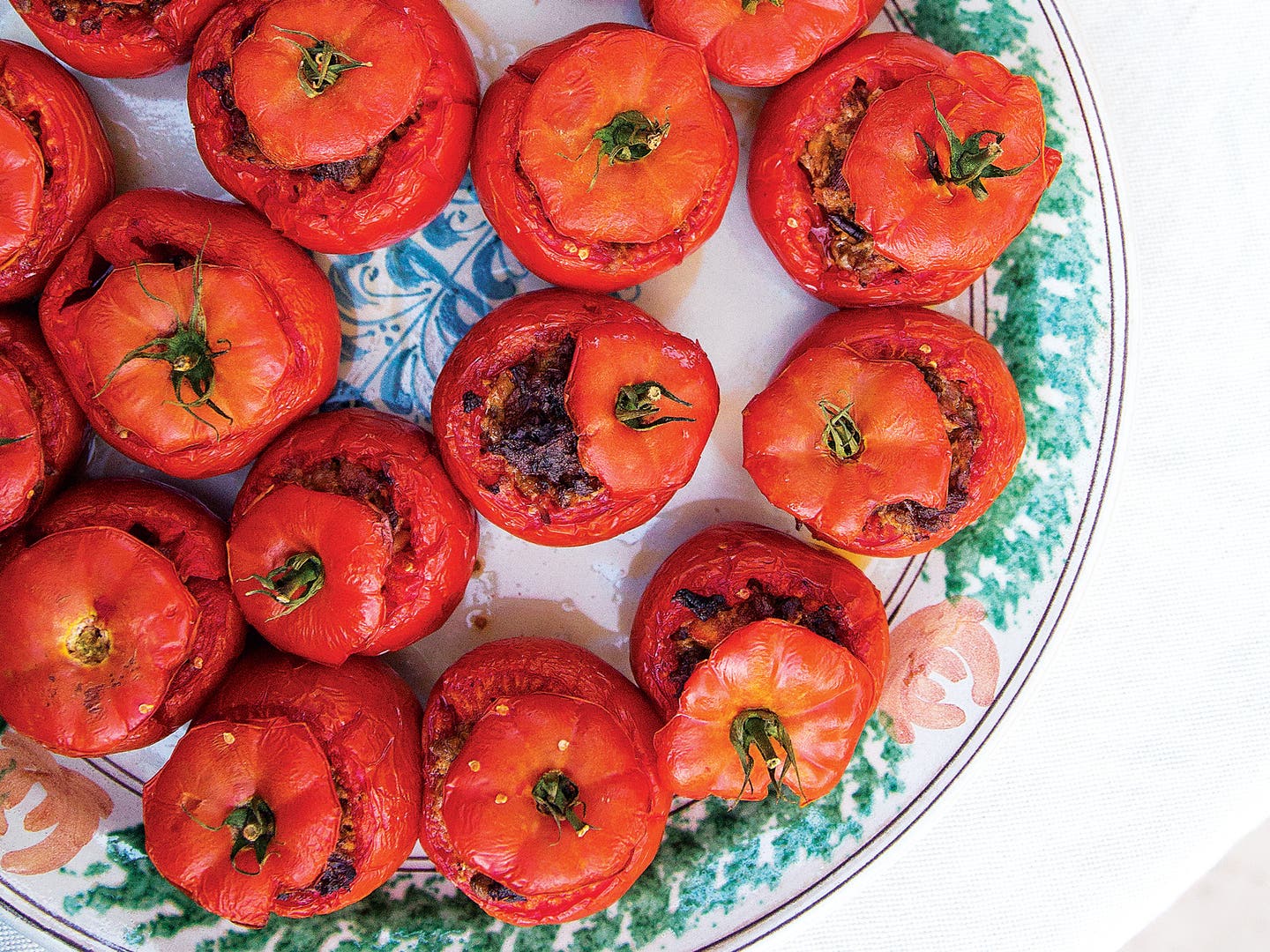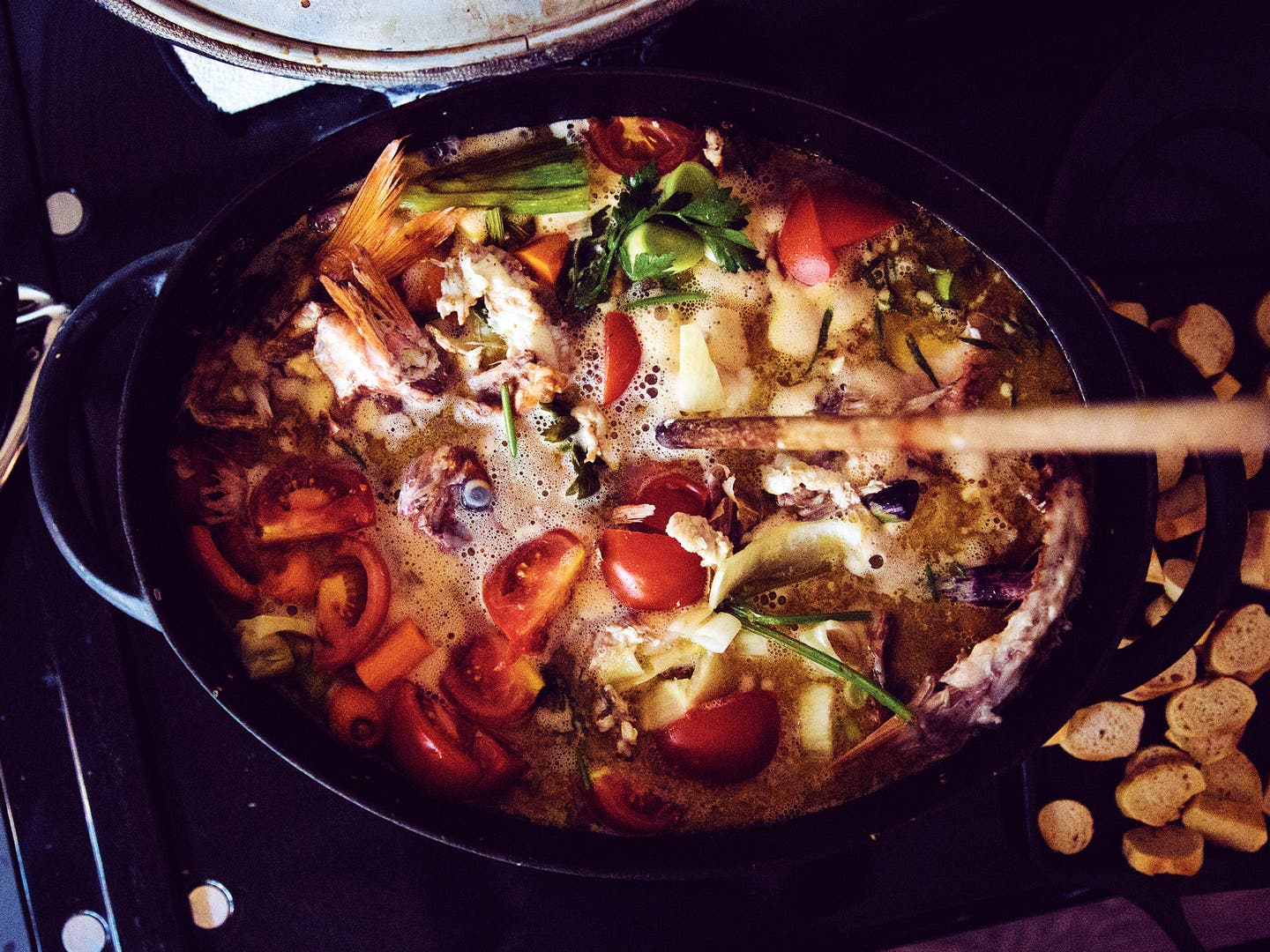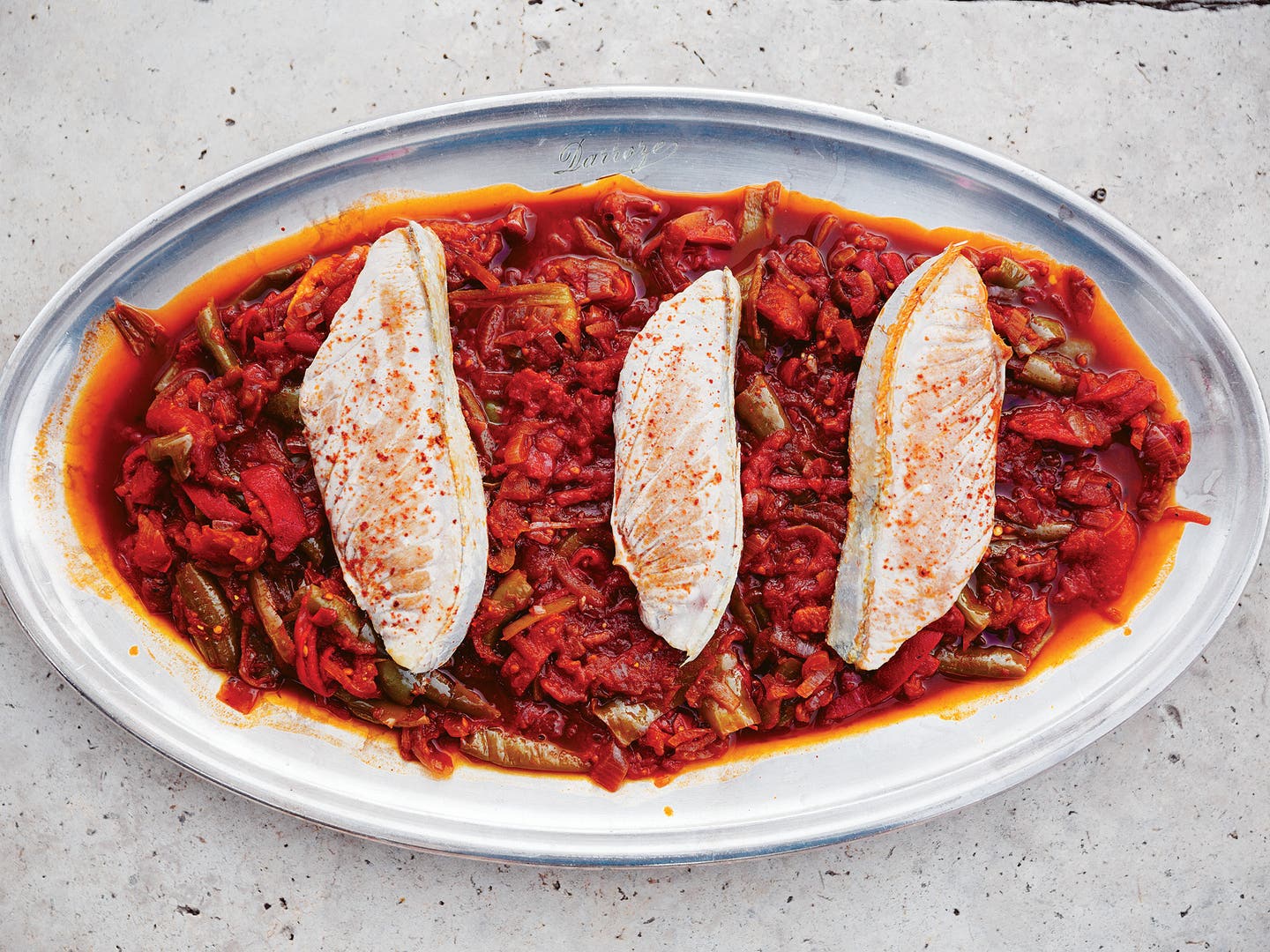
Biarritz and the Cuisine of the Sun
A gathering of revered chefs cooks its way through a family reunion on the Southwest coast of France
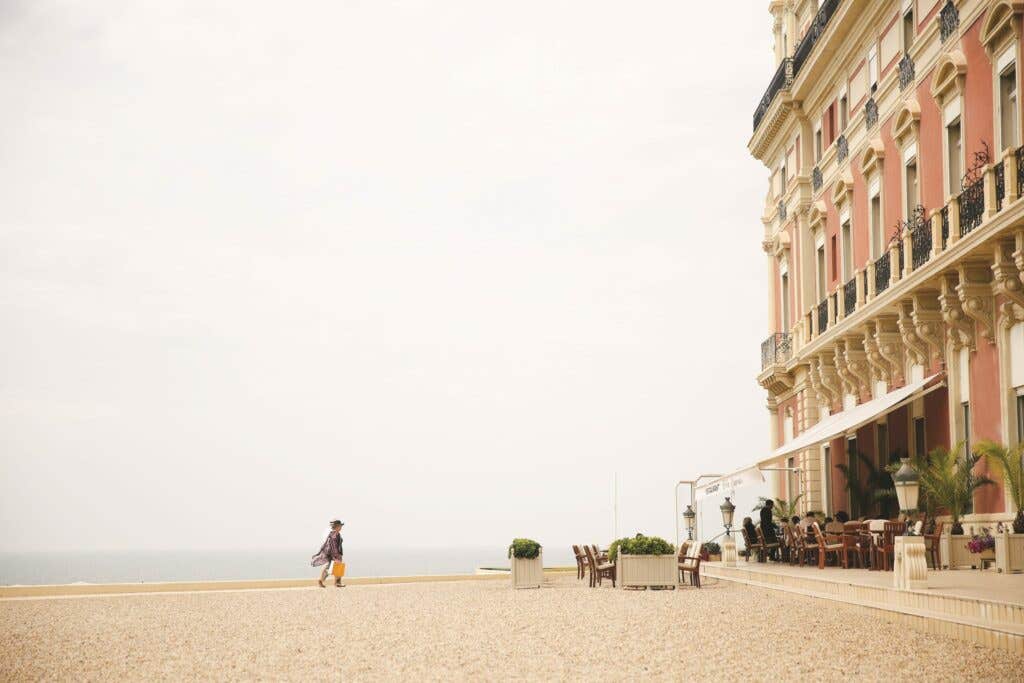
It's an August night in Biarritz, the pedestrian-only streets packed in equal measure with bronzed surfers and linen-suited high rollers. The sun is still bright in the sky, and the sound of clinking glasses, laughter, and music is layered on a thrum of waves lapping at the shore. Off rue des Halles, in a kitchen goods store turned occasional pop-up restaurant, the warm scent of star anise and cardamom settles over a long table filled with old friends. Chef Hélène Darroze, blond hair shoved under a Panama hat, has succumbed to the lure of the stove and decided to make a simple dessert of figs cooked in butter and spices. Yes, she's on vacation, but so what?
She peels a huge curl of orange rind, which blooms and perfumes the air the minute it hits the butter. Not to be outdone, Bob Jourdan, the store's proprietor, longtime friend of the Darroze family, and the evening's alleged host, flicks off the lights and brings out a pineapple with a sparkler on top. A fuzzy recording of “L'Hymne de L'Aviron Bayonnais,” the rousing song of the Bayonne rowing team—a sort of unofficial anthem of southwest France—comes on the stereo, and everyone joins in. Hélène's younger daughter Quiterie runs in from outside, her brow furrowed.
"Maman, qu'est-ce qui se passe?" she asks, voice raised over the din. Hélène pulls the seven-year-old onto her lap and comforts her with a fig. Quiterie grins and settles in, happy and unfazed to be serenaded by her mother's friends over midnight desserts garnished by sparklers, as if this happens every night of her life.
Hélène used to come to this beach town on the Basque coast in the summers as a child—she grew up in the neighboring region of Les Landes. Here, a half-hour drive from the Spanish border, streets overflow with noshers who wash down cheesy toasts with ice-cold txakoli, a crisp Basque white wine that hits the glass from an arm's length away, to stir up its gentle effervescence. Fresh fish and oysters, shells so big they fit in your palm like softballs, are hauled in each morning a few miles down the beach in Saint-Jean-de-Luz before traveling to Les Halles, the main Biarritz market, where they're stacked on ice next to heaps of dark red fraises des bois and festoons of red piment d'Espelette. And here you can become so enchanted with the cerulean blue of the ocean, its waves breaking as if on a timer, that when you finally turn your back on the water to get your bearings after a beach walk, you might find yourself in an au naturel cove by mistake and have to scamper along the rocky shore away from naked Frenchmen, wincing at every step.
This is Biarritz life, and Hélène kicks off her espadrilles and slips into its informality as seemingly effortlessly as she decided to start a family on her own.
“I got to a certain age, wanted children, and there was no man,” she explains simply. So she adopted first Charlotte, now age nine, then Quiterie, from Vietnam, a country she'd long loved because of a great aunt who lived in Hanoi.
It's the same gutsy attitude that allowed her to take over the family restaurant, Chez Darroze, in 1995, after three generations with a Darroze male at the helm, then head to the city to strike out on her own, and climb the ranks of a male-dominated industry.
She splits her time between two eponymous Michelin-starred restaurants, one on the Left Bank in Paris, the other at the Connaught Hotel in London. Until the two girls started formal school, they accompanied their mother back and forth on the Chunnel every week, because, pourquoi pas?
At her restaurants, she wows diners with dishes such as oyster tartare and white coco bean velouté, topped with caviar jelly, osetra caviar and a glinting flourish of edible silver paper. But the food-as-art, the reductions, the silky-smooth purées bolstered with generous glugs of cream and swirls of butter, are all rooted here, in the southwest of France. Though surely there is adequate poultry nearer to Paris or London, she sources special yellow chickens from Les Landes—“They are corn-fed and roam freely in the forest, making them expensive, but worth it”—red mullet and tuna from Saint-Jean-de-Luz, buttery sheep's milk cheese known as Brebis from the Basque region.
“The cuisine of my home, of the south, is the cuisine of the sun,” she says.
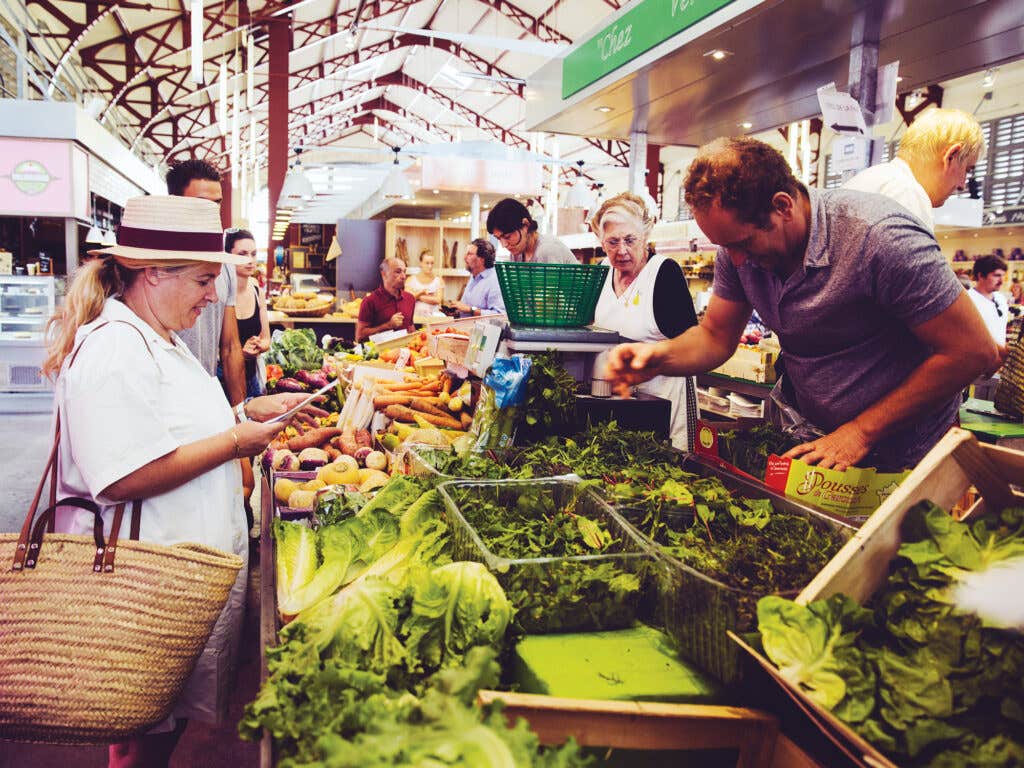
Marc Darroze lives in a converted farmhouse in the tiny town of Roquefort, down the road from the family's former restaurant, where both he and his sister grew up.
"When I'm here, I have a religion," Hélène says, standing in Marc's kitchen, prepping for an informal dinner with extended family that will include her father and uncle, both serious and revered chefs from the old guard. "I season everything with piment d'Espelette and cook everything in duck fat."
She tips a ladle of fat over a tray of tomatoes, each stuffed with a filling pour les dieux—a mixture of foie gras, duck confit, and black truffle juice—then adds a hefty dash of powdered piment d'Espelette, perches each tiny tomato hat back on top, and shoves the tray in the oven. Piment d'Espelette is nearly ubiquitous in Basque dishes and appears in neighboring regions too—by law, true ones must be grown in one of ten designated communities in Basque country. The peppers are used fresh, puréed, pickled, or dried and powdered, lending their mild heat and signature vermilion stain to everything they touch.
Les Landes, about an hour's drive north of Biarritz, is as known for its duck as Basque country is for its fish, and fittingly, above Marc's kitchen sink is a framed black-and-white photo of a regal canard, surveying the kingdom below its beak. Outside, sheep lazily chew on grass in a nearby enclosure, a warm cat stretches out in a patch of sunlight, and Charlotte and Quiterie, hair wet from the pool and clad in sundresses and tiny wellies, pick wildflowers for the night's dinner table. Hélène's father, Francis, quietly cleans squid in the sink while her mother, Annick, tidies up, and outside at the table by the pool, Uncle Claude, formerly of a Michelin-starred restaurant in Langon (his son Jean-Charles now runs it), painstakingly shucks mussels for his summer signature, moules vinaigrette. He's donned a white apron over his pressed checked button-down. ("But I cannot cook without an apron!" he'd protested after arriving.)
All is calm in the kitchen, the older generation ceding any authority it once had to the next—“We worked together for one year, and it was difficult,” is all Hélène will say about her and her father—until Claude shrieks from outside.
Tomatoes Stuffed with Foie Gras, Duck Confit, and Chanterelles (Tomates Farcies)
Tomatoes Stuffed with Foie Gras, Duck Confit, and Chanterelles (Tomates Farcies)
"Viens!" he calls to his wife, who rushes outside, alarmed. He motions to his brow. Rolling her eyes, she fetches a towel and delicately dabs his forehead. He shucks throughout.
Even as a young girl, Hélène was unafraid to throw her toque into the ring with her elders.
“I would make a whole trolley of pastries when my parents had guests over,” she remembers. “The dream everyone had was that I'd take over my mother's pharmacy and my brother Marc would take over the restaurant. But it didn't work out that way.”
Marc was more enamored with the family's armagnac business that his father had started in 1974 (“My grandfather was very harsh,” he says, deflecting the reason why he avoided the kitchen). He studied wine for years, took the helm in 1996, and now sells the regional honey-colored brandy in 50 countries. It was Hélène who, after university, headed to Monaco to see if she could work in the office of Alain Ducasse's Le Louis XV. Sensing innate culinary talent, he persuaded her to work on the line.
“He used to say I was a terrorist of taste,” she recalls, grinning to reveal a charming gap between her two front teeth. After her stint with Ducasse, she returned home to officially take over her father's restaurant and became the first woman head chef in her family line. Her grandmother, who'd passed down the stuffed tomato recipe Hélène now cooks in her honor, was a chef, too, “but in the shadow of my grandfather, ” Hélène says. In 1999, she decided to relocate to Paris and open her own restaurant, a move her family did not initially understand.
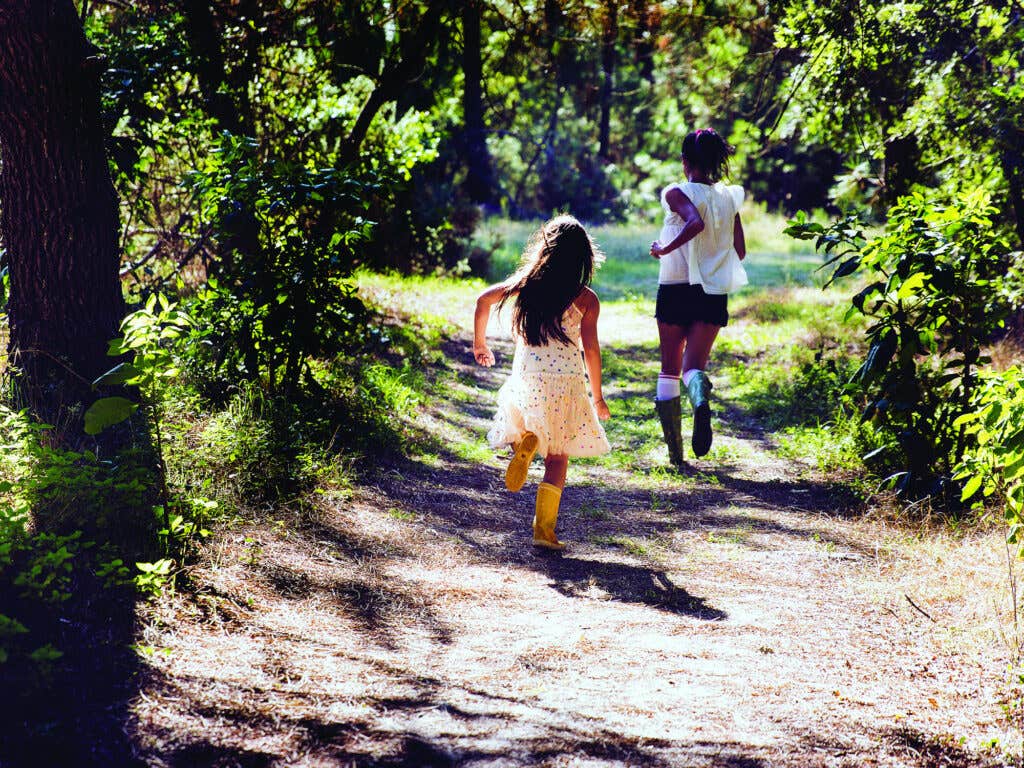
“For them, you should be loyal to your origins,” she says. “After I moved to London, years later, they got used to it and now understand that it's possible to be loyal to your origins even if you're in another place.”
But today, at least, honoring the tastes of her childhood is effortless, innate. She adds some powdered piment d'Espelette to a pan of red and green peppers, onions, and tomatoes, which will cook down all afternoon into the Basque country signature dish known as pipérade until the flavors meld and each spoonful becomes sweet and tender. Sometimes it is served with eggs. Tonight it will be a bed for thick slabs of tuna belly. Paying more attention to her girls, flitting in and out, than to the large knife in her hand, she perfectly hulls tiny fraises des bois, wild strawberries that will be tossed with fromage blanc and crumbled meringues for a slightly more refined version of a childhood treat: She used to tromp through the forest with her grandfather gathering the berries, which they'd eat with cottage cheese.
By the time dusk settles, Marc has set up the table outside, decorated with the wild flowers the girls had gathered earlier, and friends and family settle down to the potluck. They select a few mussels from the platter of Claude's moules vinaigrette, each plump, rich bite cut perfectly with the vinaigrette's acidity, then move on to slices of marbled cured Noir de Bigorre, made from black pigs raised in the region and so fatty it's slick and shiny and almost spreadable. More wine is poured as the focus shifts to the squid Francis cleaned, which has been kissed with grill marks and tossed with cubes of chorizo; to the pipérade now topped with tuna; and to a local yellow chicken served en crapaudine, or "in the style of a toad," split down the back, flattened, and garnished with slices of lemon and a scattering of herbs.
Pipérade, a sauté of onions, peppers, and tomato, adds sweet Basque flavor to tuna. Get the recipe for Basque Pipérade with Seared Tuna Steaks
Hélène spoons a stuffed tomato onto Claude's plate and is handing it over when he says, sternly, "Attend, attend! Le jus est plus importante!" He's right. His niece placates him with a spoonful composed largely of rendered foie gras and duck fat before returning the offending tomato.
A full moon has risen above the farmhouse by the time a bottle of the family's 1976 armagnac, a pack of cigarettes, and a tourtière landaise, warm from the oven, hit the table. The tart is a true celebration of the region's bounty, stuffed with armagnac-spiked apple compote and sheathed in crisp phyllo dough brushed with—what else?—duck fat. Baptiste, Marc's 12-year-old, wipes his mouth with the back of his hand after inhaling a slice and says, to no one in particular, "Un peu sec, non?" A little dry. He may have a Darth Vader mask hanging in his room and an oversize teddy bear guarding the bed, but their days appear numbered. It is clear that the fifth generation of Darroze chefs is awaiting its turn.
“Baptiste told me, ‘I want to be a chef, but not like you,’” says Hélène, laughing. “‘You never cook! You just stand there and delegate.’ It's true, I delegate. But I create. I cannot delegate creativity.”
Quiterie assumes her usual position on her mother's lap, Francis swirls and sniffs his armagnac glass and lets out a contented sigh, and Baptiste scoops up the cat, who tolerantly submits to being carried around, zombie-like, paws straight out in front.
After a particularly long toke on his cigarette, Marc exhales, smoke curling up into the air, then turns to his sister.
"Three generations all gathered around a table… La vie est simple, non?"
Basque Seafood Stew
Hearty “bouillabasque”—Darroze’s tongue-in-cheek name for a Basque-style bouillabaisse, in which the fish is cooked separately and then added to a rich, reduced seafood-and-tomato stock—perfectly marries the culinary cornerstones of southwest France: duck fat, seafood, and armagnac. You can grill the fish on grates or a plancha, in the Spanish style, but a stovetop solution works just as well. Serve with aïoli, rouille, or any garlicky mayonnaise, along with some crusty bread. Get the recipe for Basque Seafood Stew »
Get the recipe for Tomatoes Stuffed with Foie Gras, Duck Confit, and Chanterelles (Tomates Farcies) »
Get the recipe for Mussels with Herbed Vinaigrette (Moules Vinaigrette) »
Get the recipe for Basque Pipérade with Seared Tuna Steaks »
Get the recipe for Basque Seafood Stew ("Bouillabasque") »
Get the recipe for Apple and Armagnac Phyllo Pie (Tourtière Landaise) »
The Darroze Family's Armagnacs
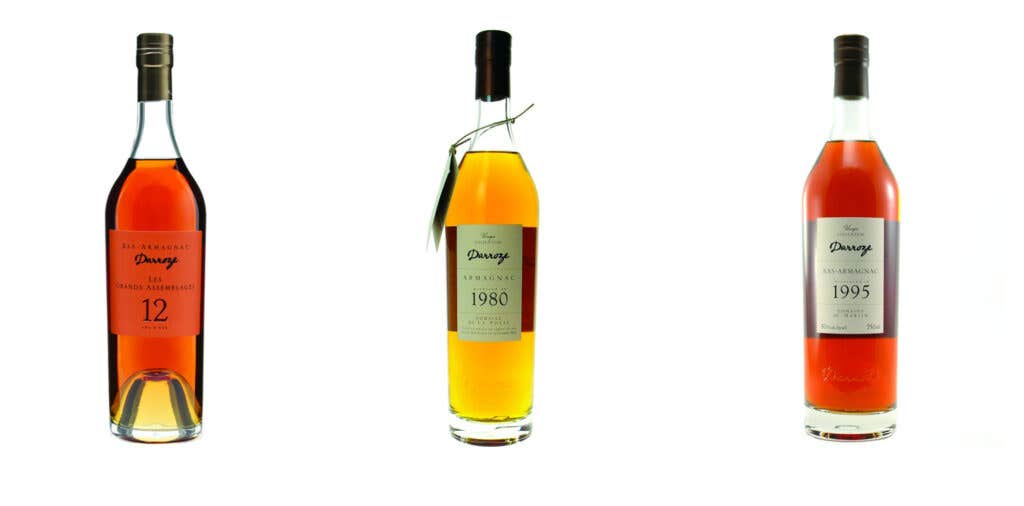
It is said the French brandy known as armagnac is the oldest distilled spirit in all of France—perhaps the world. Though Darroze Armagnac was founded only in 1974, the small, family-run brand is now considered a national treasure. In the 1970s and '80s, revered Landaise chef and company founder Francis Darroze, Marc and Hélène's father, traveled the Bas-Armagnac region, which has consistently produced the most complex brandies in France. He visited small, relatively unknown estates, buying a cask here, a bottle there, and curated a cellar that now holds 70 vintages, some dating back to 1904.
Made from grapes grown in one of three regions—Bas-Armagnac, Haut-Armagnac and Ténarèze—all armagnacs start as white wine before going through a single distillation process to produce an aromatic, bold final product. Traditionally, armagnacs are made from a blend of vintages and estates, which, along with the occasional addition of water, allows the producer to refine each batch and smooth out the final taste. Darroze Armagnac, conversely, made its name by taking a different tack: For the majority of the production, neither estates nor vintages are blended, and no water is added. The result is an armagnac that tastes particularly distinct. You'll find the name of the estate, the year of the bottling, and the year of harvesting on most Darroze labels.
In 1996, Marc took over the family business from Francis.
“My father used to tell me if I didn't do well at school, I'd have to go into the kitchen,” Marc says, only half joking. He studied winemaking all over the world, and he and his small team produce 100,000 bottles each year.
Here are three representative Darroze Armagnacs, all available at klwines.com.
Les Grands Assemblages, 12 Ans ($70)
This blended armagnac spends 12 years in contact with oak, resulting in a spicy final product with undertones of licorice and cinnamon. Let the spirit breathe for a few minutes, then use as a base for cocktails or enjoy on the rocks.
Domaine de la Poste, 1980 ($180)
Swirl this golden vintage in your glass and you'll be hit with the smells of the Bas-Armagnac region: almonds and hazelnuts, vanilla and cloves, and a hint of violet. Serve with cheese or tarte Tatin.
Domaine de Martin, 1995 ($130)
This vintage is still relatively young, so the finish is spicy and bright, though you'll still get a hit of baking spices and gingerbread on the tongue. A glass goes perfectly with chocolate or an after-dinner cigar.
Keep Reading
Continue to Next Story
